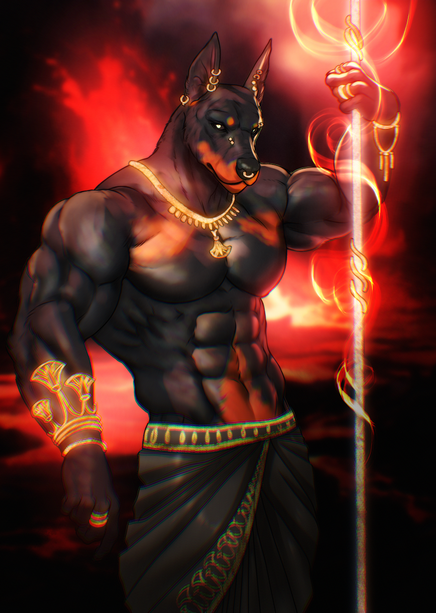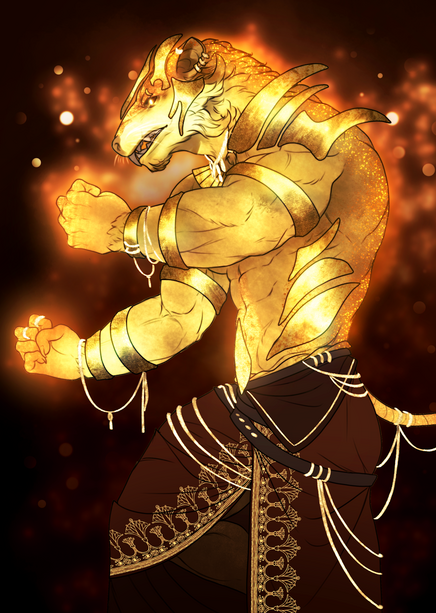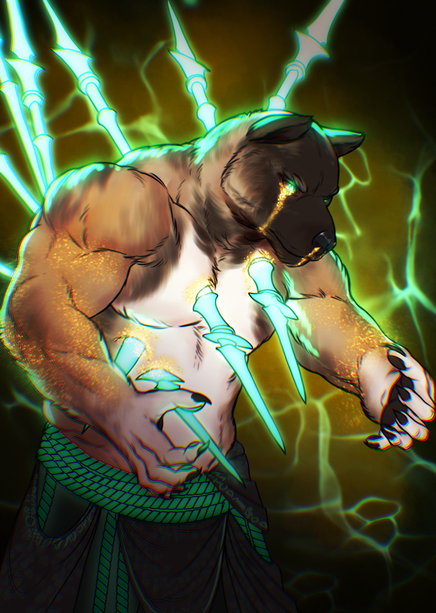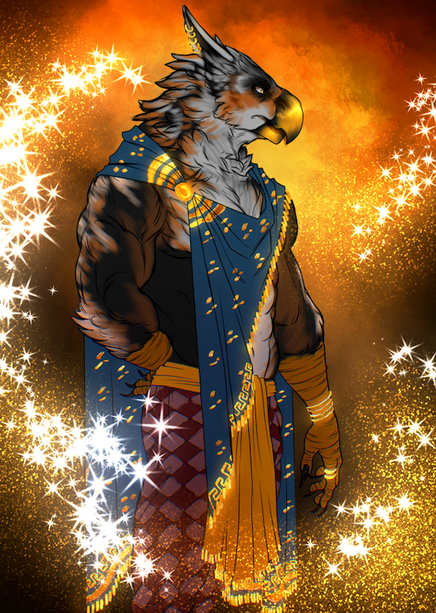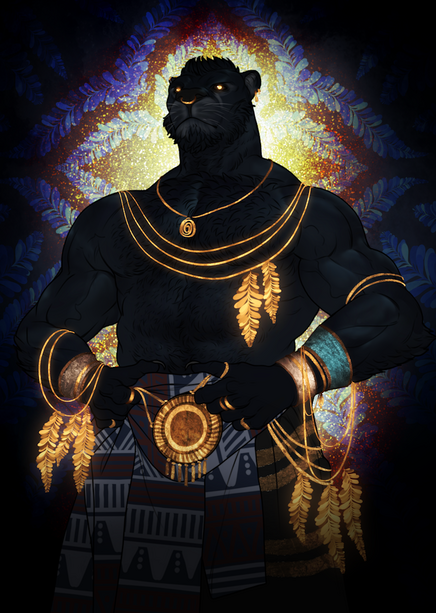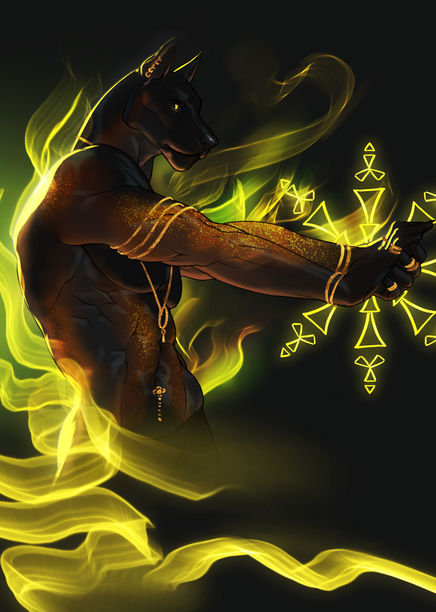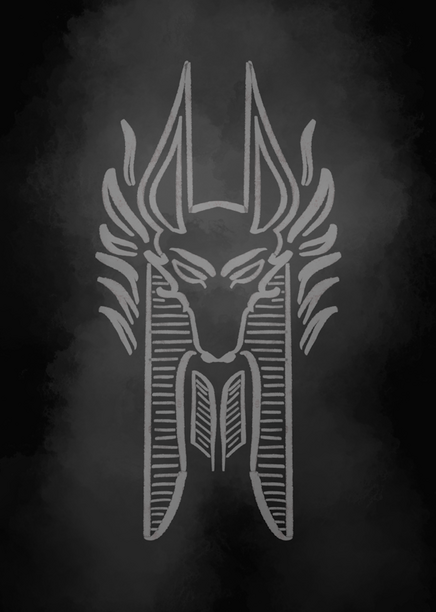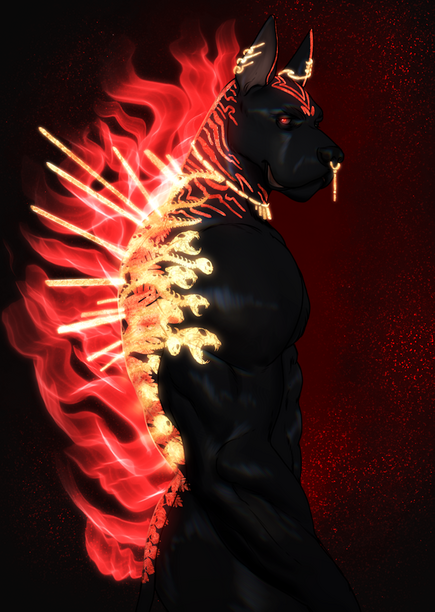More actions
Intro
Origins
Core Beliefs
Central Message
Faith Mechanic
Karma
The Afterlife
Gods and Goddesses
The Khama pantheon is made up of 12 Gods, while the Dewa Variant rejects two of these, and adds 3 back in. Khama worshipers strongly attach and associate with one patron God, but must worship all other Gods equally. Each God represents a particular contribution to Karma which should be strived after, though a good level of Karma can be acquired just by avoiding the vices that oppose the virtues of the Gods. Some of the Khama Gods lack art, depicted only with a gray symbol. This is because the Gods have not been seen since the Dewamenet Empire days, with many of the Gods being presumed dead, though efforts are being made to rediscover the lost fragments of the past.
- Tjafar also known as the Shaper God, is the leader of the Khama Pantheon. He is the God of Justice, and the law-maker of the Pantheon, setting out the codes of life that all followers live by, but also speak on the dogma of the religion itself widely speaking. Tjafar is meant to be an impartial judge in the conflicts of the Gods, but is actually one of the biggest players, thus enforcing his seniority among them in perpetuity.
- Akhet doubles both as the War and Love God for the Khama faithful, representing a consistent duality of passion and violence brought about by military conflict. He is equally a brave, disciplined soldier or commander, and a hedonistic self-indulgent adulterer who has sired many Godborn. Akhet was known as the Reclaimer during the interlude period, leading the charge of preserving the Asha people during the Pearl Wars.
- Khannar is a God of Peace brought about by Music, but his purpose has become more complicated since the Dwamenet War and Pearl Wars. Khannar represents peace as an abstract concept found in many things, such as peace at the end of war, peace in beautiful music, or seeing art, but primarily in death. Even though he is not a Death God, he is a dealer of death and a raging enemy of the Allorn seeking their utter destruction.
- Divi is the God of all good-natured qualities of the people. He represents kindness, charity, understanding, compassion, sympathy, and camaraderie. He contains within him all the good qualities that a society needs to thrive socially, and for its people to be contented with each other. Because of this, he is often also described as a happiness God, because he seeks to please others while avoiding all conflict.
- Mauthek is the God of Death. He carries the souls of the dead to the Afterlife and weighs their Karma against the weight of a golden feather. Mauthek has largely become toothless since the theft of the Afterlife by Gahan, leaving him to essentially act as doorkeeper for the Afterlife's waiting room, a position deeply insulting and humiliating, as Mauthek is an immensely dignified God who took great pride in his work.
- Zaret is the God of glee, victory in wit, and deceit. Among the Gods, he is the most mischievous, known to play tricks on the faithful for his amusement and to play great schemes over the centuries for anti-climactic conclusions. While Zaret is held with some mistrust, those who seek fortune or success with lies always end up seeking out his favor, causing him in a way to also double as a wealth-God, for great capital is built on lies.
- Athetis is the Goddess of the heavens and knowledge of the witnessing of the moon. She is the most intelligent of the Khama Gods, but also the most detached from material reality, having reached a higher understanding of the world. Her moonlight gaze pierces all lies and unknowing, meaning she is outright worshiped to acquire foresight into the unseen and knowledge of the unknown, yet her gaze is fixated on the stars.
- Qadreti is the Goddess of Change and Progress. While Qadreti was once a simple Goddess of the seasons, her identity became so much more complicated and ever-changing when she absorbed the essence of an unknown God, became metallic, and had a worship form around her that centered around replacing all body parts with living metal ones. Qadreti is also considered a Goddess of inventions as such.
- Zaret is the God of glee, victory in wit, and deceit. Among the Gods, he is the most mischievous, known to play tricks on the faithful for his amusement and to play great schemes over the centuries for anti-climactic conclusions. While Zaret is held with some mistrust, those who seek fortune or success with lies always end up seeking out his favor, causing him in a way to also double as a wealth-God, for great capital is built on lies.
- Ankheti is a Goddess of Life, which extends itself to fertility and even themes of being an earth mother in the prosperity of deep mines. It is said that she breathes life into each new faithful born to the Gods and that her identity is less the meek expectation of a benevolent protectress, and more of a violent benefactor. To Ankheti, death is the ultimate defeat, and mortals should rage against the dying of the light.
- Ra'mut is a God with wanderlust who is on an eternal journey to find new places, but also to find himself. To Ra'mut, life is a complicated journey in which new things are discovered, and new skills are gained. In his worship, the faithful pray for success in their training or honing of skills, and perfection in their execution. He is seen as a patron of hobbies and freedom, due to his carefree and curious nature.
- Pahtia is the Goddess of art and by extension of Culture. Pahtia is the most tragic of the Khama Gods, because she was very explicitly killed by the Elven Gods during the Dewamenet war, causing the events that ended that war, and all that happened after. Her death is seen as such a strong focal point of Khama history, that it has started to define all Khama and Asha art, with depictions of mortuary cults and death rites.
Dewa Variant
The Dewa Variant of Khama is nearly identical except that it has retained some of the Gods that the modern Khama faith has rejected while rejecting some of the new Gods in the Khama pantheon. It should be noted that this is a schismatic belief in theory, but in practice, they are still treated as the same Religion. There are however obvious differences:
- The Dewa Variant rejects the worship of Divi, arguing that Divi opted voluntarily to depart from the Khama pantheon, and that his reconciliation with Tjafar at a later point is mere theatrics and a divine ploy from Tjafar to expand his power. They believe Divi brings no useful things to the table.
- The Dewa Variant rejects the worship of Sefruat, arguing that Sefruat was born long after the pantheon became dysfunctional, and that the Silontaar have been so far removed from Dewa history and the source of their spiritual culture, that it is laughable to include this God in the Pantheon.
- While the Dewa Variant and the main Dogma consider each other some form of heresy, their opposition is far more benign than the schisms between the Unionist variants. There is no violence between them, and they work together against common enemies and towards common goals and holidays.
- It is entirely feasible to see a Dewa Variant and main Dogma worshiper stand side by side as avengers in the name of Khannar, beating up an Elf together while praising the Gods in unison. They work together, but pray separately in private, and have different internal monologues on Karma.
- The only marked difference between the Dewa Variant and main Dogma, is that they perform Divinium Summonings without the other present, and that they can enter the Afterlife held by Gahan in the Void, though only if they agree to become a Spirit in the Afterlife that serves him.
- Because of the inherent qualities of the Dewa Variant Gods, Khama gains a lot darker overtones when worshiped through the lens of the Dewa Variant. Dewa Variant worshipers do not reject the conflict between the Gods during the Dewamenet Days, holding a different view of Karma.
- Karma to the Dewa Variant worshipers is not the measure of a good and righteous soul, but a strong one (not in the physical sense, but in the spiritual, mental, and self-reflective sense). To them, one should not be kind because it is a good virtue, but because kindness takes mental effort.
- In short, Karma is more the cosmic weight of a soul, worn down by having taken shortcuts and easy decisions in life which show weakness and frailty, or made lighter by having made uncomfortable hard decisions, showing tenacity, dedication, resourcefulness and general strength.
- The Dewa Variant worships 3 extra Gods that the main Dogma does not. Each of these Gods committed minor crimes, but their primary reason for expulsion, is because their patronage is incompatible with modern Karma, and because their themes are deemed responsible for the Dewa Rot.
- Gahan was once the God of Order and structure, but has since become more complicated. Much of Khama society structure was ordained by Gahan, who directed the hierarchies of classes and the rules of social convention between them. However, when the Dewamenet Empire fell, he took the Afterlife, stole it into the Void, and merged it with the capital of the Dewamenet Empire to freeze it in time in another dimension.
- Kazheron is the God of Control and Power. He is no longer observed in the main Dogma, because his qualities are incompatible with the more modern interpretation of karma, the other Gods believing that the desire for control and power, inherently provoke habits that are anti-karma. Kazheron is however still worshiped by old Dewa believers for the means to control others, and thus control events around one's self.
- Nephka is the Goddess of Purity which in its simplest interpretation means an anti-Magic God. Nephka has deemed Magic a corruption of the body and soul because it is ungovernable and because it makes Karma unreadable. Charity performed by conjuring gold with Magic, is not true charity, but a false indulgence of the believer's soul. A difficult choice solved with Magic was never difficult, for Magic is always a cheat to her.
Gahan's Crime
The exact actions Gahan took that led to Kemet being created as it is known today, beg additional explanation. Gahan as a God represented state authority and structure. Much of how Dewamenet statehood was ordained and designed, was by his hand, and it was by his will that the societal structures were kept in place. He ordained the God-Kings and Queens, he ordained the nobility and the aristocrats and intelligentsia, and set up the rules of how these groups should interact, where they should live separate from the commoners and lower social castes, and what social mobility existed if at all. To Gahan, statehood was a carefully orchestrated machine that had every small aspect micromanaged to the finest detail.
When the Dewamenet Empire became the target of massive Allorn Elven Magic that would wipe out the majority of the Khama worshipers among the Asha, Gahan in a split second before the spell landed, stole the Khama afterlife, merged it with the capital of the Dewamenet Empire called Desh-eret and broke into the Void with it, thus creating a pocket-realm within this Dimension which defied its own rules. The act was so violent, that it turned all the people who lived in Desh-eret into Void Spirits, which Gahan then immediately conscripted into his Spirit army to go about conquering the other Sovereigns of the Void so that he would be the undisputed master of all Void Demons.
The exact morality of this supposed crime as Tjafar defined it, remains up for intense debate. Gahan acted without the consent of Desh-eret's inhabitants but did save them from being wiped out by Elven Magic. He did not help save the Empire at large, but saved its capital, which still exists in a perpetual stasis of re-living the last day of the Empire's fall. The inhabitants were conscripted into Demon warfare, but were given eternal life and powers beyond their imagination. The still-living Khama worshipers cannot enter the afterlife, having to resort to a pseudo afterlife created by Mauthek in the waiting room of the actual afterlife which can no longer be reached. To many Khama worshipers, Gahan is a criminal and a traitor who used what little was left for his own personal gain after cutting his losses with the other Khama Gods, and to some he remains the only savior who saw through all the insanity of the Dewamenet-Allorn War, and saved what little he could. Whatever the individual views, Gahan remains both an Evolist God trapped in the Void, and a still observed and worshiped God of the Dewa Variant of Khama.
Expanded Lore
God Family Ties
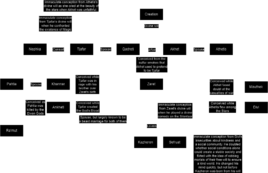
As seen in the image on the right, the Khama Gods are all related to each other in one way or another. It is unclear whether these family ties are brought about by the folklore and legends created by their followers, or whether these Gods were actually created in these exact conditions. Scholars cannot say for certain that the totality of history did not see Gods creating other Gods, and there is no definitive proof that Gods cannot sire new Gods into being when they reproduce with other Gods, it just so happens to be the case that the Gods of all currently known Religions do not procreate. As a result of these assumptions, the prevailing theory is that because the Khama Gods are from a different era in time, the Gods of that world functioned differently than modern-day Gods. Indeed, there is perhaps a theory continuation from the idea that modern Gods can observe the conflict and chaos inherent in pantheons where new Gods are born and die, and decide to avoid that same fate. The Khama Gods are some of the oldest Gods left in the world, and their idiosyncratic behavior as well as their time during the Dewamenet Empire, seems to reinforce the idea that family ties between Gods are generally a bad thing. It should also be noted, that while many of these relations seem explicitly incestuous, they are not, purely by virtue of the fact that Gods are not real people, they do not grow up together, and they have no biological connection to one another. Their essence and creation is almost entirely spiritual, and they share no deeper familial connection like mortals would understand it.
The Dewa Rot
Explain why Tjafar isn't cool with the old Gods who like bootlicking
Trivia
- The naming similarity between Kazheron and the Evolist God Katheron are no coincidence. Rather than perhaps being the same person, the name Katheron was loaned and changed in the Allorn language syllables, Allorn Elves in essence stealing his name to name one of their new Dark Gods.
